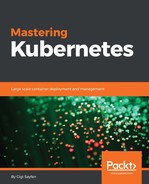- Mastering Kubernetes
- Table of Contents
- Mastering Kubernetes
- Credits
- About the Author
- About the Reviewer
- www.PacktPub.com
- Customer Feedback
- Preface
- 1. Understanding Kubernetes Architecture
- 2. Creating Kubernetes Clusters
- 3. Monitoring, Logging, and Troubleshooting
- 4. High Availability and Reliability
- High-availability concepts
- High-availability best practices
- Live cluster upgrades
- Large-cluster performance, cost, and design trade-offs
- Summary
- 5. Configuring Kubernetes Security, Limits, and Accounts
- 6. Using Critical Kubernetes Resources
- Designing the Hue platform
- Using Kubernetes to build the Hue platform
- Separating internal and external services
- Using namespace to limit access
- Launching jobs
- Kubectl get pods
- Mixing non-cluster components
- Employing init containers for orderly pod bring-up
- Evolving the Hue platform with Kubernetes
- Summary
- 7. Handling Kubernetes Storage
- Persistent volumes walkthrough
- Public storage volume types - GCE, AWS, and Azure
- GlusterFS and Ceph volumes in Kubernetes
- Flocker as a clustered container data volume manager
- Integrating enterprise storage into Kubernetes
- Summary
- 8. Running Stateful Applications with Kubernetes
- Stateful versus stateless applications in Kubernetes
- Shared environment variables versus DNS records for discovery
- Running a Cassandra cluster in Kubernetes
- Summary
- 9. Rolling Updates, Scalability, and Quotas
- Horizontal pod autoscaling
- Performing rolling updates with autoscaling
- Handling scarce resources with limits and quotas
- Choosing and managing the cluster capacity
- Pushing the envelope with Kubernetes
- Summary
- 10. Advanced Kubernetes Networking
- Understanding the Kubernetes networking model
- Kubernetes networking solutions
- Using network policies effectively
- Load balancing options
- Writing your own CNI plugin
- Summary
- 11. Running Kubernetes on Multiple Clouds and Cluster Federation
- Understanding cluster federation
- Managing a Kubernetes cluster federation
- Setting up cluster federation from the ground up
- Initial setup
- Using the official hyperkube image
- Running the federation control plane
- Registering Kubernetes clusters with federation
- Updating KubeDNS
- Shutting down the federation
- Setting up cluster federation with Kubefed
- Running federated workloads
- Summary
- 12. Customizing Kubernetes - API and Plugins
- Working with the Kubernetes API
- Extending the Kubernetes API
- Writing Kubernetes plugins
- Writing an authorization plugin
- Summary
- 13. Handling the Kubernetes Package Manager
- 14. The Future of Kubernetes
- Index
In this chapter, we've covered many topics relating to scaling Kubernetes clusters. We discussed how the horizontal pod autoscaler can automatically manage the number of running pods based CPU utilization or other metrics, how to perform rolling updates correctly and safely in the context of auto-scaling, and how to handle scarce resources via resource quotas. Then we moved on to overall capacity planning and management of the cluster's physical or virtual resources. Finally, we delved into a real-world example of scaling a single Kubernetes cluster to handle 2,000 nodes.
At this point, you have a good understanding of all the factors that come into play when a Kubernetes cluster is facing dynamic and growing workloads. You have multiple tools to choose from for planning and designing your own scaling strategy.
In Chapter 10, Advanced Kubernetes Networking, we will dive into advanced Kubernetes networking. Kubernetes has a networking model based on the Common Networking Interface (CNI) and supports multiple providers.
-
No Comment
